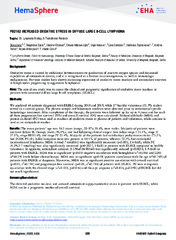Приказ основних података о документу
Increased oxidative stress in diffuse large B-cell lymphoma
| dc.creator | Antić, Darko | |
| dc.creator | Đikić, Dragoslava | |
| dc.creator | Otašević, Vladimir | |
| dc.creator | Mitrović-Ajtić, Olivera | |
| dc.creator | Vuković, Vojin | |
| dc.creator | Subotički, Tijana | |
| dc.creator | Đurašinović, Vladislava | |
| dc.creator | Tomić, Kristina | |
| dc.creator | Mihaljević, Biljana | |
| dc.creator | Čokić, Vladan | |
| dc.date.accessioned | 2024-01-29T17:32:36Z | |
| dc.date.available | 2024-01-29T17:32:36Z | |
| dc.date.issued | 2022 | |
| dc.identifier.issn | 2572-9241 | |
| dc.identifier.uri | http://rimi.imi.bg.ac.rs/handle/123456789/1428 | |
| dc.description.abstract | Background: Oxidative stress is caused by imbalance between excessive production of reactive oxygen species and decreased capabilities of antioxidant system, and it is recognized as a feature in cancerogenesis, as well in hematologic malignancies. Previous studies have shown increasing expression of oxidative stress markers and antioxidant enzymes in lymph nodes progressing to aggressive lymphomas. Aims: The aim of our study was to assess the clinical and prognostic significance of oxidative stress markers in patients with untreated diffuse large B-cell lymphoma (DLBCL). Methods: We analysed 64 patients diagnosed with DLBLC during 2018 and 2019, while 27 healthy volunteers (51.9% males) served as a control group. The plasma sample and laboratory analyses were obtained prior to initiation of specific hematologic treatment. After completion of the therapy, the patients were followed up for up to 4 years and for each of them progression free survival (PFS) and overall survival (OS) were calculated. Malondialdehyde (MDA) and protein carbonyl (PC) were used as markers of oxidative stress in plasma of patients and volunteers, while catalase is used as an antioxidant marker. Results: The mean patients’ age was 56.2 years (range, 20–87); 51.6% were males. Majority of patients were analysed before 1L therapy (n=61; 95,3%), and had following clinical stages: Ann Arbor stage I 23.4%, stage II 37.5%, stage III 15.6% and stage IV 23.4%. Majority of the patients had satisfactory performance status (73.5% had ECOG PS ≥1), bulky tumorous mass was present in 34.4% of patients, whereas 70.3% had extranodal localisation of lymphoma. MDA (6.66±2.7 nmol/ml) was significantly increased (p<0.001, 2.6-fold), while PC (4.29±2.7 nmol/mg) was also significantly increased (p=0.0027, 5-fold) in patients with DLBCL compared to healthy volunteers. In opposite, antioxidant catalase (0.194±0.06 IU/ml) was significantly reduced (p=0.0034, 1.9-fold) in patients with DLBCL. MDA was in significant (p<0.05) negative correlation with hemoglobin (r2=0.586) and LDH (r2=0.59) levels before chemotherapy. MDA was in significant (p<0.01) positive correlation with the age (r2=0.769) of patients with DLBCL at diagnosis. Moreover, MDA was in significant positive correlation with overall survival (p<0.01, r2=0.736) and progression-free survival (p<0.01, r2=0.736) of patients with DLBCL. PC was in negative correlation with the clinical stage (r2=0.103, p=0.146) and therapy response (r2=0.136, p=0.091) of DLBCL but did not reach significance. Summary/Conclusion: The elevated oxidative markers and reduced antioxidant support oxidative stress in patients with DLBCL, while MDA can be a prognostic marker of overall survival. | sr |
| dc.language.iso | en | sr |
| dc.publisher | Wolters Kluwer Health, Inc | sr |
| dc.rights | openAccess | sr |
| dc.rights.uri | https://creativecommons.org/licenses/by-nc-nd/4.0/ | |
| dc.source | HemaSphere | |
| dc.title | Increased oxidative stress in diffuse large B-cell lymphoma | sr |
| dc.type | conferenceObject | sr |
| dc.rights.license | BY-NC-ND | sr |
| dc.citation.issue | S3 | |
| dc.citation.spage | 3741 | |
| dc.citation.volume | 6 | |
| dc.identifier.doi | 10.1097/01.HS9.0000851476.12536.06 | |
| dc.identifier.fulltext | http://rimi.imi.bg.ac.rs/bitstream/id/3341/Increased_oxidative_stress_in_diffuse_large_B-cell_lymphoma_conf_2022.pdf | |
| dc.type.version | publishedVersion | sr |

